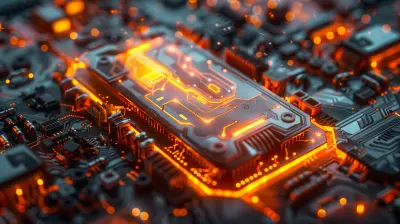14 April 2025
Technology has been weaving its way into fashion for years, but nothing quite compares to the rise of smart fabrics. Imagine clothes that can change colors, track your health, or even charge your smartphone—sounds like something out of a sci-fi movie, right? Well, the future is here, and smart textiles are revolutionizing the way we think about clothing.
With advancements in nanotechnology, conductive fibers, and AI-driven innovations, fabrics are no longer just about style and comfort; they’re now intelligent, functional, and interactive. Let’s take a deep dive into how these cutting-edge materials are shaping the fashion industry and what we can expect in the years ahead.

What Are Smart Fabrics?
At their core, smart fabrics (or e-textiles) are materials engineered to interact with their environment or respond to stimuli, such as temperature, moisture, or pressure. These textiles integrate electronics, sensors, and other digital components to enhance functionality beyond traditional fabrics.There are two key types of smart fabrics:
1. Passive Smart Fabrics – These fabrics can sense environmental changes (like temperature shifts) but don’t actively respond. Think UV-protective clothing that blocks harmful rays.
2. Active Smart Fabrics – These materials not only detect stimuli but also adapt or react accordingly. This includes self-heating jackets, moisture-wicking sportswear, and textiles that can communicate with your smartphone.

How Smart Fabrics Are Transforming Fashion
Fashion has always been about expression, comfort, and innovation. Now, technology is making it even smarter. From runways to everyday wear, let’s break down the ways smart fabrics are making waves.1. Health Monitoring and Fitness Tracking
Forget traditional fitness trackers strapped to your wrist—what if your clothes could monitor your heart rate, track movement, or analyze your posture? Smart fabrics embedded with biometric sensors are making this possible.For instance, companies like Hexoskin and Sensoria are developing wearable smart clothing that tracks real-time body metrics. These garments can help athletes optimize their performance while also offering health benefits to individuals who need constant monitoring—like heart patients or those recovering from injuries.
2. Temperature-Regulating Clothing
Have you ever stepped outside and immediately regretted your outfit choice because the weather was unpredictable? With adaptive smart fabrics, that could be a thing of the past.Take ClimaWear and Outlast, for example. These fabrics adjust their insulation based on external temperatures, ensuring you stay warm when it’s cold and cool when it’s hot. This kind of innovation is particularly useful for outdoor enthusiasts, athletes, and people constantly on the go.
3. Color-Changing and Interactive Fashion
Wouldn’t it be cool if your clothes could change color based on your mood or sync with your phone to display notifications? This isn’t futuristic fantasy anymore—it’s happening now.Innovations like E-Ink fabrics and thermo-reactive dyes give garments the ability to shift colors in real-time. Designers like Anouk Wipprecht have even created interactive dresses that react to emotions or environmental stimuli, taking personal expression to a whole new level.
4. Self-Cleaning and Stain-Resistant Clothing
Nobody enjoys doing laundry, and with advancements in self-cleaning textiles, you might not have to as often. Scientists have developed fabrics coated with nano-particles that repel water, dirt, and bacteria.For instance, Silic, a startup specializing in hydrophobic clothing, has created t-shirts that resist spills and stains—perfect for those who always manage to spill coffee on themselves. These fabrics not only save time but also prolong the life of clothing, contributing to a more sustainable fashion industry.
5. Energy-Harvesting Wearables
What if your clothes could charge your phone or power small electronic devices? Researchers are working on fabrics embedded with piezoelectric fibers, which generate electricity from movement.Imagine jogging in the morning and having your phone charge from the kinetic energy you produce. Companies like Vollebak and University of Manchester researchers are actively developing these fabrics, aiming to merge convenience with sustainability.

The Role of AI and IoT in Smart Fabrics
The rise of Artificial Intelligence (AI) and the Internet of Things (IoT) has played a huge role in advancing smart textiles. These cutting-edge technologies allow clothing to connect with other smart devices, process data in real-time, and provide insightful feedback.For example, AI-integrated garments can track daily health patterns and send alerts if an abnormality is detected. Similarly, IoT-enabled fabrics can sync with your smart home devices, adjusting lighting or climate control based on body temperature.

Challenges in the Smart Fabric Industry
Like any breakthrough technology, smart fabrics face several challenges before they become mainstream.1. Durability and Washability – Since these fabrics contain electronics, ensuring they survive regular washing and daily wear is still a challenge.
2. Cost of Production – High-tech fabrics often come with hefty price tags, making them inaccessible to the average consumer.
3. Battery and Power Issues – Some smart fabrics require external or built-in power sources, which can be bulky or inconvenient.
4. Privacy Concerns – As more data gets collected from these wearables, concerns about security and data privacy are growing.
Despite these hurdles, ongoing research and breakthroughs are steadily improving these technologies, making them more practical and accessible.
The Future of Smart Fabrics
So, what does the future hold for smart textiles? The possibilities are endless.- Fully Biodegradable Smart Fabrics – Researchers are working on eco-friendly materials that dissolve after a certain period, promoting sustainability.
- Emotion-Sensing Clothing – AI-powered fabrics that respond to mood changes by adjusting texture, temperature, or display visuals.
- Wearables for Medical Applications – Future smart fabrics could act as early warning systems for diseases by analyzing sweat or skin conditions.
With tech giants and fashion designers collaborating like never before, the fusion of fashion and technology will only continue to evolve. Smart fabrics are not just a trend—they're shaping the future of what we wear and how we interact with clothing.
Final Thoughts
Smart fabrics are changing the game in fashion and wearable technology. Whether it’s clothes that charge your phone, monitor your health, or adjust to the climate, these innovations are making life more convenient, sustainable, and stylish.While challenges remain, the potential for smart textiles is enormous. As researchers, designers, and engineers continue to push boundaries, we can expect a future where our clothes do more than just cover us—they enhance our lives in ways we never thought possible.
The next time you buy a new outfit, don’t be surprised if it does more than just look good. The future of fashion is smart, and it’s only getting started.





Elijah Adkins
Oh great, just what we need—clothes that can track our heartbeats while we binge-watch on the couch. Fashion and fitness, finally joined in their quest to mock our laziness!
April 21, 2025 at 12:37 PM